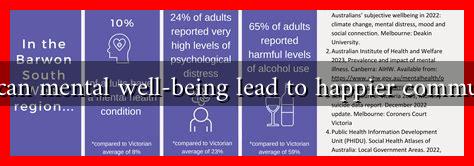-
Table of Contents
- How Can Mental Well-Being Lead to Happier Communities?
- The Link Between Mental Well-Being and Community Happiness
- Case Studies: Successful Community Initiatives
- 1. The “Happy City” Project in Canada
- 2. The Mental Health Initiative in Bhutan
- Statistics Highlighting the Importance of Mental Well-Being
- Strategies for Promoting Mental Well-Being in Communities
- Conclusion
How Can Mental Well-Being Lead to Happier Communities?
Mental well-being is a crucial aspect of individual health that significantly impacts the overall happiness and functionality of communities. As societies become increasingly aware of the importance of mental health, it is essential to explore how fostering mental well-being can lead to more vibrant, cohesive, and happier communities. This article delves into the relationship between mental well-being and community happiness, supported by research, case studies, and practical examples.
The Link Between Mental Well-Being and Community Happiness
Mental well-being encompasses emotional, psychological, and social health. It affects how individuals think, feel, and act, influencing their interactions with others and their environment. When individuals experience good mental health, they are more likely to contribute positively to their communities. Here are some key ways mental well-being fosters happier communities:
- Increased Social Cohesion: Individuals with good mental health are more likely to engage in social activities, fostering connections and building relationships within the community.
- Enhanced Productivity: Mentally healthy individuals tend to be more productive, contributing to local economies and community initiatives.
- Reduced Crime Rates: Communities with higher levels of mental well-being often experience lower crime rates, as individuals are less likely to engage in harmful behaviors.
- Improved Public Health: Mental well-being is linked to physical health; healthier individuals contribute to a more robust community health profile.
Case Studies: Successful Community Initiatives
Several communities around the world have implemented initiatives aimed at improving mental well-being, resulting in happier and more cohesive environments. Here are a few notable examples:
1. The “Happy City” Project in Canada
The “Happy City” project in Vancouver, Canada, focuses on urban design that promotes mental well-being. By creating green spaces, walkable neighborhoods, and community gathering areas, the initiative has led to increased social interactions and improved mental health among residents. According to a study by the University of British Columbia, residents in neighborhoods with more green spaces reported higher levels of happiness and lower levels of stress.
2. The Mental Health Initiative in Bhutan
Bhutan is known for its unique approach to measuring happiness through Gross National Happiness (GNH). The country prioritizes mental well-being in its policies, integrating mental health services into primary healthcare. This holistic approach has resulted in a more content population, with studies indicating that Bhutanese citizens report higher levels of life satisfaction compared to many other nations.
Statistics Highlighting the Importance of Mental Well-Being
Research underscores the significance of mental well-being in fostering happier communities. Here are some compelling statistics:
- According to the World Health Organization (WHO), depression is the leading cause of disability worldwide, affecting over 264 million people.
- A study published in the Journal of Happiness Studies found that communities with higher levels of mental well-being reported a 20% increase in overall happiness.
- Research from the Mental Health Foundation indicates that 1 in 4 people will experience a mental health problem in their lifetime, highlighting the need for community support systems.
Strategies for Promoting Mental Well-Being in Communities
To cultivate mental well-being and, consequently, happier communities, several strategies can be implemented:
- Community Support Programs: Establishing support groups and mental health resources can provide individuals with the help they need.
- Awareness Campaigns: Educating the public about mental health can reduce stigma and encourage individuals to seek help.
- Accessible Mental Health Services: Ensuring that mental health services are available and affordable is crucial for community well-being.
- Encouraging Social Interaction: Organizing community events and activities can foster connections and improve social cohesion.
Conclusion
In conclusion, mental well-being is a cornerstone of happier communities. By prioritizing mental health, communities can enhance social cohesion, reduce crime rates, and improve overall public health. The examples of successful initiatives in Canada and Bhutan illustrate the profound impact that mental well-being can have on community happiness. As we move forward, it is essential for policymakers, community leaders, and individuals to work together to create environments that support mental health, ultimately leading to more vibrant and joyful communities.
For more information on mental health initiatives and resources, visit the MentalHealth.gov.


